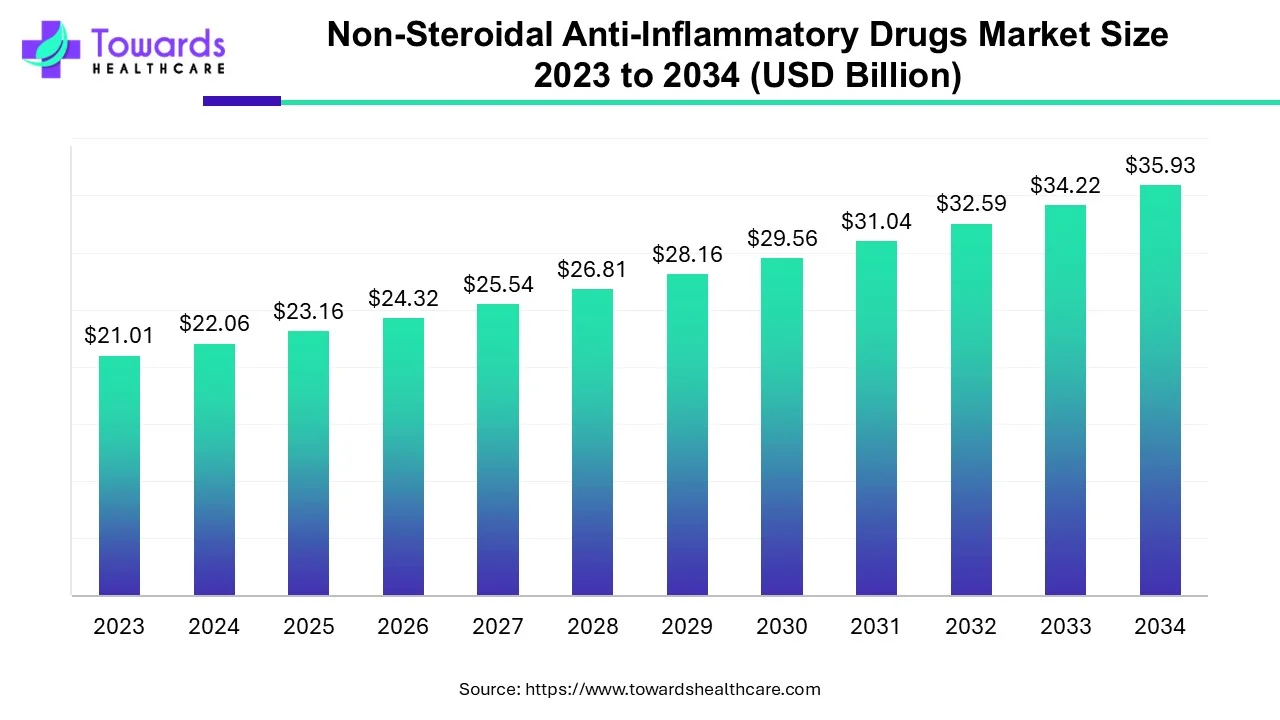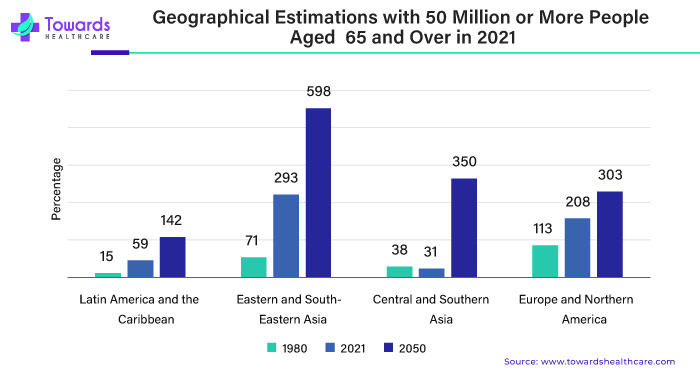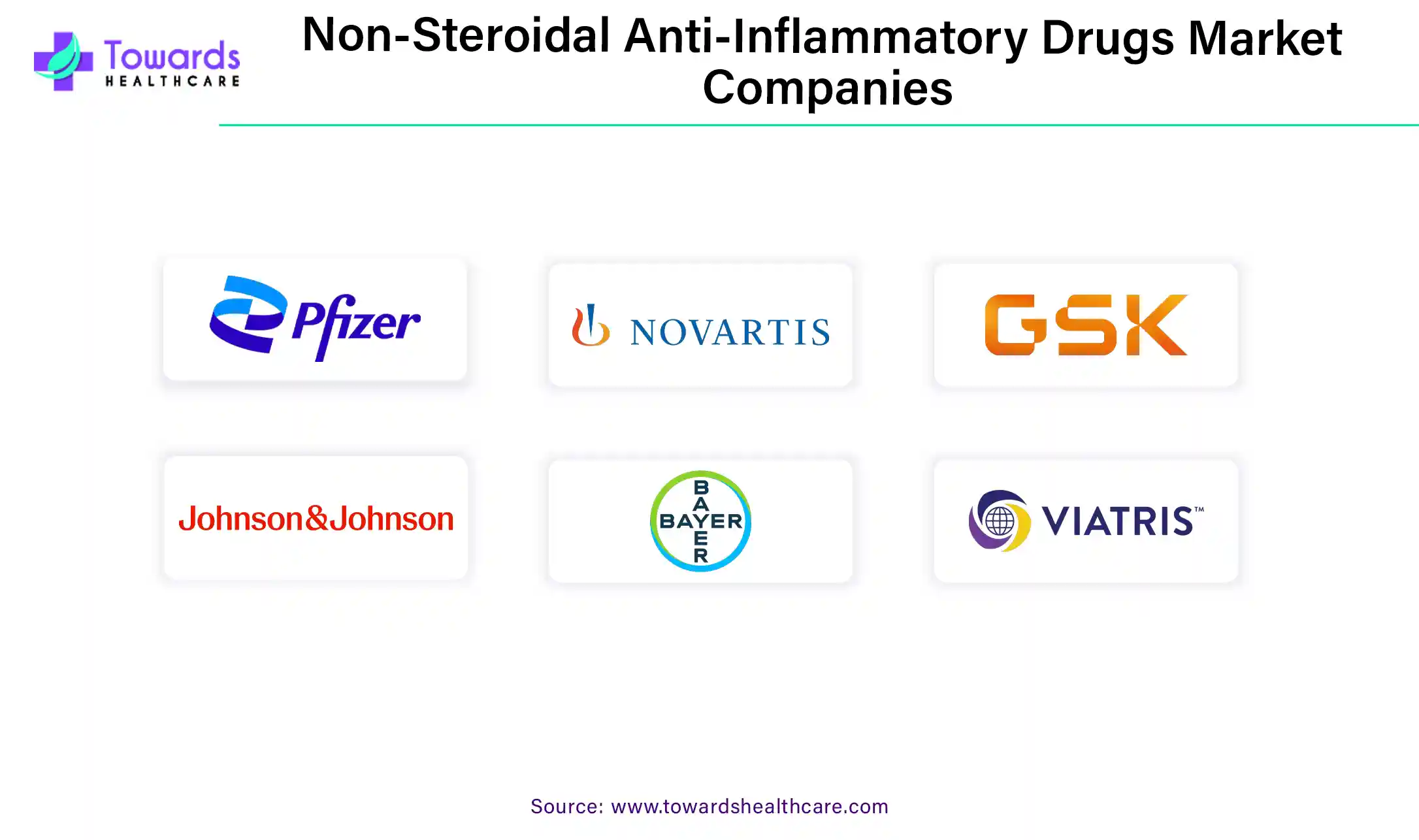April 2025

The non-steroidal anti-inflammatory drugs market is projected to reach USD 35.93 billion by 2034, growing from USD 23.16 billion in 2025, at a CAGR of 5% during the forecast period from 2025 to 2034.

The Centers for Disease Control and Prevention reports roughly 1 in 5 adults in the U.S., around 53.2 million people, have arthritis. It's more common in women (20.9%) than men (16.3%). Nonsteroidal anti-inflammatory drugs are highly recommended for managing the pain.
Non-steroidal anti-inflammatory drugs are commonly used to relieve pain, reduce inflammation, and lower fever. They are widely used to treat arthritis, muscle aches, headaches, menstrual cramps, and minor injuries like sprains and strains. NSAIDs block the production of chemicals in the body called prostaglandins, which are responsible for pain and inflammation.
These medications are often found in over-the-counter forms like ibuprofen (Advil, Motrin), naproxen (Aleve), and prescription-strength versions. NSAIDs are usually available in oral form, but some can be applied topically as creams or gels for localized pain relief.
For instance,
Non-steroidal anti-inflammatory drugs are essential because they effectively relieve pain and inflammation, allowing people to manage various conditions and improve their quality of life. They are particularly beneficial for individuals suffering from chronic conditions like arthritis, with persistent inflammation and pain. The global demand for non-steroidal anti-inflammatory drugs has increased significantly due to several factors. The prevalence of conditions like arthritis, which require long-term management, has risen with aging populations worldwide.
For instance,

The accessibility of non-steroidal anti-inflammatory drugs, both over-the-counter and through prescription, has made them widely available and commonly used. Additionally, non-steroidal anti-inflammatory drugs are often preferred over opioid medications for pain relief due to their lower risk of addiction and fewer side effects, contributing to their growing demand.
Non-steroidal anti-inflammatory drugs have become more widely used in developing countries as healthcare infrastructure improves and awareness of their benefits spreads. As people become more health-conscious and seek effective pain management solutions, the demand for non-steroidal anti-inflammatory drugs continues to rise globally. It's important to note that non-steroidal anti-inflammatory drugs can have side effects, including gastrointestinal issues and an increased risk of heart problems, so it's essential to use them responsibly under the guidance of a healthcare professional.
The concern over opioid addiction and abuse has pushed people to seek safer alternatives for managing pain, leading to a rise in the use of non-opioid options like non-steroidal anti-inflammatory drugs. Unlike opioids, which can be addictive and have serious side effects, non-steroidal anti-inflammatory drugs offer effective pain relief with a lower risk of addiction.
Non-steroidal anti-inflammatory drugs help by reducing swelling and stopping pain signals. They're often used for arthritis, headaches, and muscle strains and are favored by many people and doctors for being effective with few side effects.
The accessibility of non-steroidal anti-inflammatory drugs plays a significant role in their increased usage. These medications are readily available over the counter in pharmacies and grocery stores, making them easily accessible to consumers without needing a prescription. This convenience further contributes to the growing demand for non-steroidal anti-inflammatory drugs. In addition to medical settings, non-steroidal anti-inflammatory drugs have also gained popularity in consumer markets. People are increasingly turning to over-the-counter, non-steroidal anti-inflammatory drug products for quick relief from minor aches and pains. This shift in consumer behavior reflects a broader cultural awareness of the risks associated with opioids and a preference for safer alternatives.
Furthermore, healthcare professionals are more likely to recommend non-steroidal anti-inflammatory drugs as a first-line treatment for pain management due to their established safety profile and efficacy. This recommendation contributes to the overall increase in non-steroidal anti-inflammatory drugs usage across various patient populations.
The growing preference for non-opioid pain management options like non-steroidal anti-inflammatory drugs is driven by concerns about opioid addiction and abuse, coupled with the effectiveness, accessibility, and safety of non-steroidal anti-inflammatory drugs. As a result, these medications have become indispensable tools in both medical and consumer settings for managing pain and improving quality of life.
Advancements in drug delivery technologies have revolutionized how medications like non-steroidal anti-inflammatory drugs are administered and utilized. One significant innovation is the development of topical non-steroidal anti-inflammatory drug formulations, which are creams, gels, or patches applied directly to the skin over the affected area. These formulations allow non-steroidal anti-inflammatory drugs to be absorbed through the skin and directly target the source of pain or inflammation. This targeted delivery method enhances the efficacy of non-steroidal anti-inflammatory drugs and minimizes systemic side effects.
Another noteworthy advancement is the creation of sustained-release formulations of non-steroidal anti-inflammatory drugs. Unlike traditional immediate-release non-steroidal anti-inflammatory drugs, which provide quick but short-lived relief, sustained-release formulations release the medication gradually over an extended period. This prolonged release mechanism ensures a steady level of non-steroidal anti-inflammatory drugs in the bloodstream, resulting in longer-lasting pain relief and fewer doses needed throughout the day.
Due to the involvement of numerous market players in non-steroidal anti-inflammatory drugs research, production, and marketing, they frequently devise organic and inorganic expansion strategies to enhance their presence.
For instance,
These innovations in drug delivery technology offer several advantages. Topical non-steroidal anti-inflammatory drug formulations provide localized pain relief without the need for systemic absorption, reducing the risk of gastrointestinal side effects commonly associated with oral NSAIDs. Additionally, they offer convenience and ease of use, allowing patients to apply the medication directly to the affected area as needed.
Sustained-release formulations of non-steroidal anti-inflammatory drugs offer benefits such as improved patient compliance, as they require less frequent dosing than immediate-release formulations. They provide consistent pain relief over an extended period, enhancing patient comfort and quality of life.
The introduction of these advanced drug delivery technologies has expanded the options available for pain management, catering to patients' diverse needs and preferences. They have also spurred innovation in the pharmaceutical industry, driving research and development efforts to create even more effective and convenient non-steroidal anti-inflammatory drug formulations.
Advancements in drug delivery technologies have transformed the landscape of non-steroidal anti-inflammatory drug administration, offering safer, more effective, and more convenient options for pain relief. These innovations are crucial in driving market growth by meeting the growing demand for improved pain management solutions worldwide.
The oral segment of Non-steroidal Anti-inflammatory Drugs holds a crucial position in the market, primarily due to its widespread use for pain relief and inflammation management. Available in various forms like tablets, capsules, and liquids, oral non-steroidal anti-inflammatory drugs offer convenience and accessibility to patients seeking relief from conditions such as arthritis, headaches, menstrual cramps, and injuries. Their over-the-counter availability and prescription options ensure easy access for needy individuals.
Oral non-steroidal anti-inflammatory drugs are highly versatile, effectively addressing a broad spectrum of pain and inflammation-related issues, making them a preferred choice for many patients. Unlike topical or injectable non-steroidal anti-inflammatory drugs targeting localized pain, oral non-steroidal anti-inflammatory drugs provide systemic relief, simultaneously reaching throughout the body to alleviate pain in multiple areas. Safety and efficacy are key factors driving the demand for oral non-, non-steroidal anti-inflammatory drugs. Extensive research has established their safety profile when used appropriately, instilling confidence among patients and healthcare providers. Oral non-steroidal anti-inflammatory drugs are considered effective in relieving moderate to severe pain and inflammation, further enhancing their appeal.
The ease of administration associated with oral non-steroidal anti-inflammatory drugs promotes patient compliance with treatment regimens, which is especially important for managing chronic conditions requiring long-term pain management. Additionally, as healthcare infrastructure improves in developing countries, there's a growing demand for accessible and affordable pain management options, driving the global market expansion of oral non-steroidal anti-inflammatory drugs.
Continuous advancements in oral non-steroidal anti-inflammatory drug formulations, such as extended-release versions offering longer-lasting pain relief and reduced dosing frequency, contribute to their market growth and appeal. As the global population ages and the prevalence of chronic pain conditions continues to rise, the demand for oral non-steroidal anti-inflammatory drugs is expected to persist, ensuring their significance in the pain management market for the foreseeable future.
Alternative therapies like physical therapy, acupuncture, and herbal supplements are becoming more popular as people seek different ways to manage pain alongside traditional medications like non-steroidal anti-inflammatory drugs. These therapies offer alternative approaches to pain relief, focusing on holistic healing and natural remedies. Physical therapy involves exercises, stretches, and techniques to improve mobility, strength, and flexibility, which can help reduce pain and improve overall function. Acupuncture, a traditional Chinese therapy, uses thin needles inserted into specific body points to boost energy flow and ease pain. Herbal supplements from natural sources are thought to relieve pain and inflammation due to their analgesic and anti-inflammatory properties.
The increasing popularity of these alternative therapies poses a challenge to non-steroidal anti-inflammatory drugs as they compete for market share in the pain management sector. Pharmaceutical companies must demonstrate the superiority of their non-steroidal anti-inflammatory drugs by highlighting their effectiveness, safety, and reliability compared to alternative therapies.
While alternative therapies may offer benefits such as reduced side effects and a focus on holistic wellness, non-steroidal anti-inflammatory drugs provide quick and targeted relief from pain and inflammation. They are backed by extensive research and clinical evidence, making them a trusted option for many patients and healthcare providers.
Pharmaceutical companies must invest in research and development to innovate and improve non-steroidal anti-inflammatory drug formulations, ensuring they remain competitive despite growing interest in alternative therapies. By demonstrating the unique advantages of non-steroidal anti-inflammatory drugs, such as the rapid onset of action and predictable dosing, companies can maintain their market position and continue to meet the diverse needs of patients seeking effective pain relief. Additionally, collaboration between conventional and alternative medicine practitioners can offer patients a comprehensive approach to pain management, combining the benefits of both NSAIDs and alternative therapies for optimal outcomes.
In North America, the market for Non-steroidal Anti-inflammatory Drugs is significant because many people live there, and there are a lot of health problems like arthritis and chronic pain. These medicines are commonly used to treat these conditions. North America has advanced hospitals and clinics, making getting these medicines easier when needed. Many big companies in North America create and sell non-steroidal anti-inflammatory drugs. These companies spend a lot of money on research to ensure the medicines are safe and work well. They also do a lot of advertising to inform people about their products. The government in North America, like the F.D.A. in the United States and Health Canada, makes sure that non-steroidal anti-inflammatory drugs are safe to use. They check the medicines before they can be sold and keep an eye on them even after they're on the market to ensure they're still safe for people to use.
The Asia Pacific region large population, and with better healthcare and more chronic diseases like arthritis, the demand for non-steroidal anti-inflammatory drugs is increasing. The government does affect the non-steroidal anti-inflammatory drugs market. Policies about prices, what treatments get paid for, and how medicines are approved all shape the market. Places like Southeast Asia and South Asia are getting richer quickly.
This means more people can afford non-steroidal anti-inflammatory drugs, creating new opportunities for companies to sell their products. Many companies are trying to sell non-steroidal anti-inflammatory drugs in Asia Pacific, so it's a competitive market. To do well, companies need to keep improving their products and finding new ways to deliver them.
The competitive landscape for the non-steroidal anti-inflammatory drugs market is like a giant playground where different companies compete to sell their products. Big and small companies are making and trying to convince doctors and patients that their products are the most effective and safest. They advertise, offer discounts, and sometimes even develop new and improved versions to stay ahead of the competition. There are also smaller players, including generic drug manufacturers, who make cheaper versions of non-steroidal anti-inflammatory drugs once the patents of the big companies expire. They may have different brand recognition, but they offer affordable options for patients. Companies are always looking for ways to stand out in this competitive landscape. They invest in research and development to improve their products or develop new formulations that work better or have fewer side effects. They also monitor what their competitors are doing and try to stay one step ahead.

By Disease Type
By Route of Administration
By Distribution Channel
By Geography
April 2025
April 2025
April 2025
March 2025